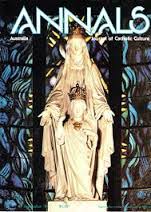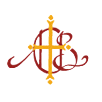Page Contents
As an evangelising organisation, the Catholic Church has used the technology of the day to communicate its message widely. In the nineteenth and early twentieth centuries that was mainly print newspapers and magazines. Later radio, television and the internet partly superseded print.
For the historian, newspapers and journals are the most prolific primary source for the thought of past times, giving a level of detail in time and space not otherwise achievable.
Beginnings

The Australasian Chronicle was founded in Sydney in 1839 to defend Catholic principles and interests at a time of increasing sectarianism. It was edited by the distinguished Scottish journalist W.A. Duncan. (Trove archive 1839-43; as the Morning Chronicle 1843-6; as the Sydney Chronicle 1846-8) The story is told in Colin Fowler’s ‘Anti-Catholic polemic at the origins of Australia’s first Catholic newspaper‘, JACHS 37 (2) (2016).
Sydney
The Freeman’s Journal was founded in 1850 by Archdeacon McEncroe and represented especially Irish Catholic interests. (Trove archive) It was renamed the Catholic Freeman’s Journal in 1932 (Trove archive)

The alternative Sydney Catholic paper, The Catholic Press (1895-1940) (Trove archive) maintained during WWI an aggressive anti-conscriptionist stance under editor J. Tighe Ryan. It merged with the Catholic Freeman’s Journal to form the Catholic Weekly (Trove archive 1942-1954), edited by Jim Kelleher, then Kevin Hilferty.
Two regional papers, the Bathurst Diocese Record (1877-1931) and the Newcastle and Maitland Catholic Sentinel (1931-1967) are available.
In 1947, Sydney church entities established La Fiamma, an Italian newspaper intended to combat left-wing influences in the Italian community.
Melbourne
Samuel Vincent Winter founded The Advocate in 1868. It imported Gaelic type to allow Dr Nicholas O’Donnell to write a column on Irish questions in Gaelic. It was under lay control until 1919, when Mannix forced its sale to himself. Michael Costigan describes his extensive reporting of Vatican II in The Advocate in ‘Vatican II as I experienced it‘, JACHS 33 (2012). (his career) The Advocate under Costigan’s editorship lost its battle for editorial independence in the late 1960s and became, like most recent Catholic newspapers, a house journal. It ceased publication in 1990. (Trove archive 1868-1954)
The Tribune (1900-1971) was a competing paper. (Trove archive 1914-1918)
Brisbane
The Catholic Leader (originally the Catholic Age) was founded in Brisbane in 1892. Brian Doyle, the managing editor from 1959 to 1981, defended lay journalism against clerical intervention.
The Catholic Advocate was an independent newspaper from 1911 to 1930 (Trove archive 1911-1928)
Adelaide
The Irish Harp and Farmers’ Herald, published from 1869 to 1873, was strongly critical of the local bishop’s excommunication of Mary MacKillop. (Trove archive) It was succeeded briefly by The Harp and Southern Cross (Trove archive 1873-5) and then by The Southern Cross, which is still published. (Trove archive 1889-1954)
Perth
The Record has been published from 1874. An archive from 1892 is being developed. See also the Trove archive 1888-1922. It still exists as an online journal and print magazine.
Tasmania
The Catholic Standard, published from 1867, and other Catholic newspapers, are in the process of digitisation.
Magazines
A vigorous Catholic intellectual life in Melbourne centred around the journal Austral Light (1892-1920), as described in Patrick Morgan’s Melbourne Before Mannix.

Annals Australasia, founded in 1889 by the Missionaries of the Sacred Heart, was edited for most of the years from 1964 to 2019 by Fr Paul Stenhouse as a general magazine of Catholic intellectual culture. (archive)
More devotional in focus were the Jesuit Messenger of the Sacred Heart (1880-1993), Madonna, published since 1897 and The Magellan, published since 1949. Far East, published since 1920, showcases the missionary work of the Columbans, as did Harvest (1951-84) for the Marist Fathers.
With Mannix’s encouragement, B.A. Santamaria and the Campion Society established the Catholic Worker in 1936 as a journal of anti-capitalist, anti-communist opinion. By the 1950s, Santamaria’s views appeared in his Freedom, later News Weekly, while the Catholic Worker became more left-wing. Its opposition to Mannix during the Labor Split of 1955 led him to ban it from the Cathedral and many parishes followed suit.
The Jesuit-run Institute of Social Order published the serious magazines of social issues Twentieth Century and Social Survey.
Patrick O’Farrell edited the liberal magazine Manna in the 1960s.
Manly (1920-1971), the organ of the Manly Union of priests associated with Manly Seminary, dealt with such issues as the Australianisation of the Church. The Swag, the quarterly journal of the National Council of Priests has hosted some lively debates since 1968.
Eureka Street AD2000, and MercatorNet have debated social and church issues in recent decades.
The National Library of Australia’s classification ‘Catholic Church-Australia-Periodicals‘ lists dozens of items.
The history of the Australasian Catholic Press Association since 1955 is described in Frank Freeman’s What’s the Story?
Journals
The Australasian Catholic Record was founded in 1895 by Cardinal Moran to confront “Irreligion, Immorality and Anarchy”, and took a combative though also theologically rather diverse line. It ceased publication in 1913 but was refounded in 1923 by Archbishop Sheehan. It has published on Australian church history, theology, ethics, pastoral care, mission, spirituality and education and has aimed mainly at a clerical audience, especially in earlier years. In the mid-twentieth century, it was known for its column on subtle questions of moral theology, such as “Is it permitted to deliberately confess to a deaf priest?” The 1952 article ‘Priestly perfection’ by James Madden, President of Manly Seminary, represents a high point of clericalism, asserting that “the Priesthood … does not produce perfection, it supposes it already.”
Compass Theology Review was founded by the Missionaries of the Sacred Heart in 1967, in the turbulent times after Vatican II. It survived for fifty years. Peter Malone tells the story in Compass Theology Review: A History. The Australian Ejournal of Theology was published in Brisbane 2003-13 (archive)
The Nelen Yubu Missiological Journal (1980-2002) dealt mainly with the interface between Aboriginal society and evangelisation.
Notre Dame University’s journal Solidarity publishes on Catholic social thought and secular ethics.
ACHS has published the Journal of the Australian Catholic Historical Society since 1954. Other historical journals are Footprints, published by the Melbourne Diocesan Historical Commission, and the Proceedings of the Brisbane Catholic Historical Society.
See also the page on Australian Catholic Intellectual Life.
Pamphlets
In the early to mid twentieth century, cheap pamphlets were a common mode of mass communication.
The sixpenny “Green Catechism” (1938 edition) was widely used in schools to inculcate the basics of faith by rote learning.

The Australian Catholic Truth Society, founded in 1904, printed over a thousand pamphlets that were available at the back of churches for a small charge. Typical subjects were saints, scruples, “teenage topics“, Freemasonry, credit societies, and papal encyclicals. The text of a selection of them is available here.
Pamphlets were used for political polemics, such as Cardinal Moran’s ‘Rights and Duties of Labour‘ (1891) and Dr P.J. Ryan‘s anti-communist ‘Dean Hewlett Johnson’s Socialist Sixth of the World‘ (c. 1942) and ‘Said Comrade Sharkey’ (1944), (see Sharkey’s ‘Reply to Father Ryan‘)
Radio and television
Fr James Meany, parish priest of St Mark’s Drummoyne, established the commerical radio station 2SM in Sydney in 1931. Its programs included Dr Rumble‘s Question Box, which answered questions about the Catholic faith (later published as Radio Replies).
Cradio was founded in 2010 to provide online radio and podcasts.
There have been a few ventures into television.
Thanks to Emilie Ng for suggesting the writing of this page.
Send corrections and suggestions for this page to
